Mid-early high-yielding gooseberry variety Kolobok
Kolobok is one of the most popular gooseberry varieties. The choice of gardeners is due to the taste of the fruit and the almost complete absence of thorns on the bushes, which makes harvesting much easier. Next, we will talk about other advantages of this variety and the requirements it places on planting and care.
Description of the gooseberry variety Kolobok
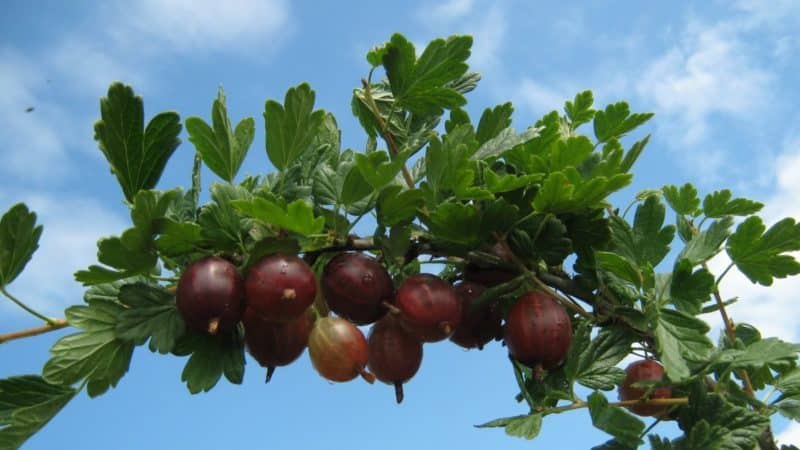
Kolobok – gooseberry average ripening period. If the summer is dry and warm, the harvest is harvested in the second half of July; in rainy weather, they focus on the color of the skin, which should turn pink.
100 g of Kolobok fruit contains 9% sugars, 2.7% acid and 25 mg of ascorbic acid.
At a temperature of 0...+1°C, the crop is stored for 2-3 weeks.
Reference. Productivity reaches 10 kg per bush.
History of origin and distribution
The variety was bred by the breeder of the All-Russian Breeding and Technological Institute of Horticulture and Nursery I. Popova in the late 1980s. as a result of crossing Change and Pink-2.
It was included in the State Register of Russia in 1988 with permission for cultivation in the Central, Central Black Earth, Volga-Vyatka and East Siberian regions.
Characteristics and description of bushes
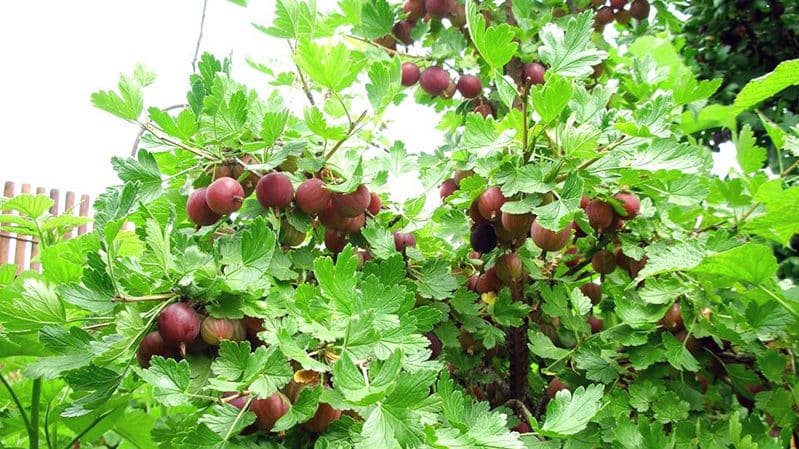
The plant is a medium-sized (1-1.5 m high), dense, medium-spreading bush with numerous thin shoots, on the lower part of which there are single, short and weak thorns.
Young branches are colored green and have slight pubescence; adult, lignified shoots are light gray. The leaves are green, large, with smooth edges, soft and slightly shiny.
The flowering period occurs at the end of April. At this time, light green flowers of medium or large size with a pink border, arranged singly and in pairs, appear on the bushes.
Temperature resistance
The variety is characterized by an average degree of frost resistance. The bushes tolerate a short drop in air temperature to –24…–27°C, but suffer from alternating thaws and frosts if it is accompanied by sudden temperature changes.
Moisture and drought resistance
Kolobok cannot tolerate long-term drought, and short-term drought negatively affects the quality of the crop - the berries grow small and flabby, and their shelf life is reduced.
Resistance to diseases and pests
The variety is resistant to powdery mildew and anthracnose, but can be affected by goblet rust. Dangerous pests include bud moths, moths, aphids and sawflies.
Characteristics and description of fruits
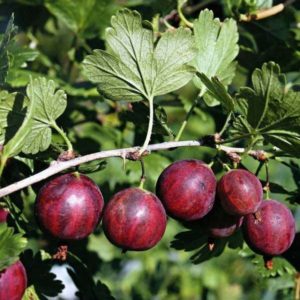
The berries are round or slightly elongated, large - weighing on average 4-8 g. They contain 18-20 small seeds. Covered with a smooth, medium-dense skin of a rich dark red color with an intense layer of waxy coating.
The pulp is slightly crispy, juicy, has a sweet and sour taste and a pleasant aroma.
Application area
Kolobok fruits are suitable for fresh consumption and freezing. They are used for making juices, jams, preserves and other preparations.
Advantages and disadvantages compared to other varieties and hybrids
Compared to other varieties of medium-ripening gooseberries, Kolobok is considered early-fruiting - the bushes begin to bear fruit 2-3 years after planting. In addition, Kolobok has the following advantages:
- frost resistance;
- extended fruiting period;
- large size, pleasant taste, keeping quality and transportability of fruits;
- resistance to characteristic diseases;
- weak thorniness of bushes;
- survival rate of cuttings;
- high productivity;
- lack of tendency to shed berries;
- ease of care.
Flaws:
- tendency to thicken the crown;
- spreading of bushes;
- lack of resistance to temperature changes and drought.
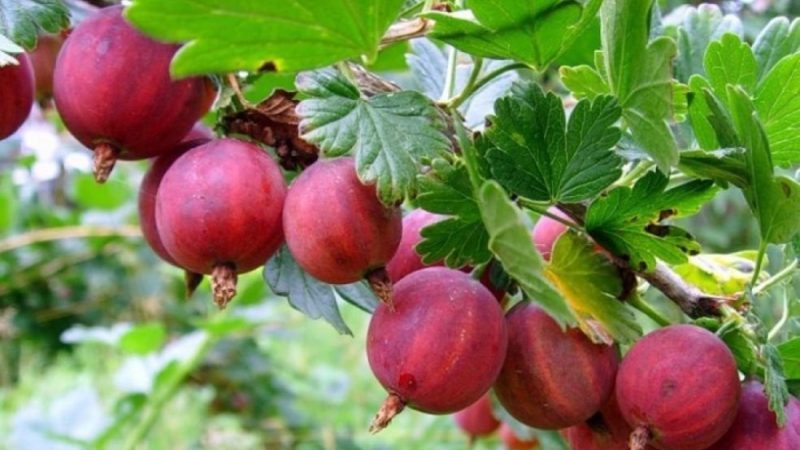
Growing technology
For Kolobok cultivation to be successful, it is important to correctly select and prepare the site and planting material.
Preference is given to 1- or 2-year-old seedlings with a developed, not overdried root system and 3-4 healthy shoots without signs diseases and damage. Before planting, leave roots for 20-30 minutes. soak in a solution of sodium humate (3 tablespoons per 5 liters of water).
Optimal conditions
Gooseberries are planted in a place that is lit and protected from drafts. The minimum permissible level of groundwater is 2 m. This way the soil will be sufficiently moist, but not swampy, which will avoid rotting of the plant root system.
The variety prefers loose, nutritious soil with neutral or weak (pH 5.5-6.0) acidity. Grows well in sandy, sandy loam, loamy and clay soil.
Reference. Kolobok is not planted after raspberries and currants. The best predecessors are potatoes, legumes, beets.
2-3 months before planting the seedlings, the area is cleared of weeds manually or using herbicides, 2-3 kg of organic fertilizers are applied per 1 m² of land, dug up with a shovel and watered.
If the soil is depleted, it is additionally fed with superphosphate, potassium chloride and urea (50 g, 20 g and 25-30 g, respectively, per 1 m²).To improve aeration, add coarse river sand.
Landing dates and rules
In the southern regions and central Russia, gooseberries are planted in the ground in mid-October, 15-20 days before the first frost. In this case, the roots will have time to strengthen and grow. Spring planting is permissible in the Urals and Siberia no later than the beginning of April and only if the roots are pre-treated with the Epin or Zircon biostimulant.
Landing rules:
- In the prepared area, dig planting holes measuring 50x50 cm.
- Add a nutritious soil mixture to the bottom of each (half of the dug up soil, 5-7 kg of humus and 40-50 g of superphosphate and potassium sulfate), pour in 1-2 buckets of water.
- Place the seedlings in the hole strictly vertically (autumn planting) or at an angle of 45° (spring planting), straighten the roots.
- Cover each rhizome with soil so that the root collar is buried 5-7 cm, compact the soil.
- Water the plants at the rate of 10 liters of water per bush.
- Trim the shoots with pruning shears, leaving a maximum of 5-6 buds on each.
- Mulch the soil with peat, rotted manure, sawdust or agrofibre.
The distance between rows should be 2-2.5 m, between bushes - 1.5 m.
Further care
If the planting site is chosen correctly, watering is only relevant in dry summers. In this case, the bushes are watered 1-2 times a week, spending about 20 liters of water each. It is especially important to monitor soil moisture during the period of flowering, active shoot growth and fruit formation.
Attention! Water is poured strictly at the root. The sprinkling method is prohibited, since water getting on the leaves provokes fungal diseases and sunburn.
A day after rain or watering, the soil in the tree trunk circle is shallowly loosened and weeded.
The plants are fed annually in the fall, 3 years after planting the seedlings. For each bush add 0.5 buckets of compost, 50 g of superphosphate, 25 g of ammonium sulfate and 25 g of potassium sulfate. At the beginning of spring, nitrogen-containing fertilizers are used to stimulate the growth of green mass, and during the flowering period, wood ash is used.
The bushes of this gooseberry variety are prone to thickening, so the shoots are regularly thinned out. A year after planting, in the spring, weak and frostbitten branches are removed. After harvesting, formative pruning is carried out: the shoots are cut in half so that the top bud grows inside the bush.
For 2-3 years in autumn All shoots are cut from the bush, leaving a maximum of 8 of the strongest ones, which are shortened by half. By 4 years the bush is considered mature. Only dry, damaged branches or shoots that grow inward and thicken the crown are periodically cut off from it.
Important! Violation of agrotechnical requirements leads to a decrease in yield and loss of sweetness and aroma in fruits.
Possible problems, diseases, pests
Diseases and pests, dangerous for Kolobok, are presented in the table.
| Disease/pest | Signs | Treatment/prevention |
| Glass rust | Bright orange swellings form on the leaves and shoots. The shoots bend and die closer to winter. | For prevention, bushes after flowering are sprayed with copper oxychloride. Infected plants are treated with a solution of Bordeaux mixture. |
| Bud moth | Insect larvae damage buds and berries, and in winter also shoots. Adult pests lay eggs in green fruits, which is why they do not ripen. | To combat insects, bushes before and after flowering are treated with Decis, Fufanon, Karbofos, Bitoxibacillin, Aktara, Trichodermin, Actellik, Lepidocid. |
| Fires | The bushes are stunted and lose their ovaries, which reduces the yield. | |
| Aphid | The larvae live on the leaves of the plant and feed on their juices, deforming the internodes. | |
| Sawfly | Pests damage plant ovaries. The larvae eat seeds and chew through berries. |
Wintering
After autumn pruning, the ground is cleared of weeds, dug up and the tree trunk circle is mulched with spruce branches or agrofibre. Gooseberry bushes are treated with fungicides “Decis”, “Fufanon”, “Aktara” and water-recharging (winter) irrigation is carried out, pouring 40-50 liters of water under each plant.
In the middle zone, the branches of the bushes are collected together and tied in the middle, after which the plants are covered with spunbond or other material.
Reproduction
Gooseberries are propagated vegetatively: by layering, cuttings and dividing the bush.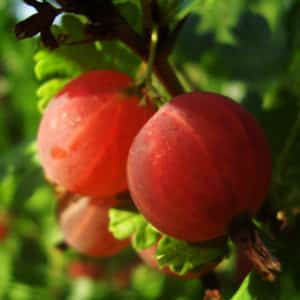
When propagating by layering, make a hole under the bush, select a strong side shoot, bend it down, lay it on the bottom of the hole, secure it with staples and sprinkle it with earth. When it forms an independent root system, it is separated from the mother bush and transplanted to a permanent place.
For cuttings, several annual shoots are cut, cut into cuttings 8-10 cm long, dipped in a solution of growth stimulator "Kornevin" or "Epin" and planted in moist, fertile soil in a greenhouse at an angle of 45°.
When dividing a bush, the mother plant is dug up and divided into several parts so that each has 2-3 side shoots and part of the rhizome. The cuttings are planted in a permanent place, the branches on them are shortened by a third.
Reference. The optimal time for work is autumn, after harvesting.
Features of cultivation depending on the region
The variety was bred specifically for central Russia. It also grows further north, but in these areas the plant cannot reach its potential.
In the north, the bushes freeze and need winter shelter. Here, seedlings are planted in the spring, which reduces their survival rate.
Pollinator varieties
Kolobok does not need pollinators, but if other varieties grow nearby, its yield increases. Universal pollen donors are varieties Plum, Rozovy-2, Russian.
Reference. Gooseberries depend on bees. An apiary located nearby increases the number of ovaries by 4-5 times and has a positive effect on the quality and size of the berries.
Reviews from summer residents

The Kolobok variety has received many positive reviews from gardeners.
Maxim, Smolensk region: “I’ve been growing Kolobok, a proven variety, for a long time. It bears fruit every year; I collect at least 6 kg of berries from one bush. They taste sweet, with a slight sourness, and everyone in our family loves them.”
Evgeniy, Moscow region: “About 10 years ago I planted 4 Kolobok bushes, I don’t regret it and I’m even thinking about planting more. The gooseberries have never gotten sick, and this is provided that I do not carry out preventive treatment. The berries are large and tasty. The only thing you have to tinker with is pruning, but this is a matter of habit.”
Conclusion
Kolobok is a frost-resistant and high-yielding gooseberry variety of domestic selection. Among its advantages, especially early fruiting, pleasant taste of fruits, resistance to diseases and ease of care are highlighted.